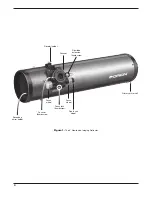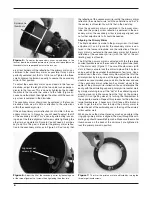
3
Congratulations on your purchase of an Orion 6"
Newtonian Imaging Reflector.
Your 6" Newtonian Imaging Reflector is a Newtonian reflec
tor telescope with high quality optics and excellent mechani
cal construction. It has been specially optimized for use with
astronomical CCD imaging cameras. These instructions will
help you set up and use your telescope.
Getting started
The 6" Newtonian Imaging Reflector comes nearly fully
assembled from the factory. The telescope’s optics have been
installed and collimated, so you should not have to make any
adjustments to them.
Please keep the original shipping box! In the unlikely event
you should need to ship the telescope back to Orion for war
ranty repair service, you should use the original packaging.
The box also makes a very good container for storing the tele
scope when it is not in use.
attaching the 6" newtonian imaging reflector to
a Mount
The 6" Newtonian Imaging Reflector can be attached to a
mount by the use of optional tube rings. Tube rings with an
inner diameter of 182mm (7.16"), such as Orion item #7375,
are needed. First attach the tube rings to your telescope
mount, then place the optical tube in the tube rings.
use of optional Finder scope and Eyepieces
The 6" Newtonian Imaging Reflector OTA does not come with
a finder scope or eyepieces in order to grant the user the great
est versatility in customizing the instrument to suit their tastes.
However, certain rules for using accessories still apply.
To connect a finder scope, simply unthread the thumbscrew
on the dovetail holder (Figure 1), and insert the base of the
finder scope bracket. Retighten the thumbscrew to secure the
finder scope and bracket in place. Finder scopes that do not
use a dovetail bracket will need to be attached by some other
means.
Almost any 1.25" or 2" eyepiece can be used with the 6" New
tonian Imaging Reflector.
To use 2" eyepieces, you will need to remove the 1.25" eye
piece adapter by loosening the drawtube thumbscrew by a
few turns and lifting the adapter out of the focuser. Place your
2" eyepiece in the focuser drawtube and secure it in place
with the thumbscrew.
In order to use a 1.25" eyepiece in the focuser, the 1.25" eye
piece adapter is needed. Place this adapter into the drawtube
like a 2" eyepiece, and loosely secure it with the thumbscrew.
Insert a 1.25" eyepiece into the adapter, and secure the eye
piece by further tightening the thumbscrew. Tightening the
thumbscrew compresses the 1.25" eyepiece adapter, which
in turn secures and precisely centers the 1.25" eyepiece.
the Dual‑speed low‑Profile crayford Focuser
The 6" Newtonian Imaging Reflector comes equipped with a
highquality dualspeed lowprofile Crayford focuser. Crayford
focusers generally perform better than rackandpinion mod
els because the design eliminates “focus shift.” Focus shift
occurs when an image changes position in the eyepiece dur
ing focusing. The Crayford design provides constant tension
via four “roller bearings” and the focus shaft, so the drawtube
cannot move perpendicular to the desired motion.
The Crayford focuser provides a minimum focus height of
43mm, which is excellent for imaging applications that require
extra intravel. The focuser also features a builtin extendable
drawtube which adds up to 44mm of travel yielding a total
focus range of 68mm. Extension of this drawtube is required
to achieve focus in an eyepiece with the telescope. To extend
the drawtube, loosen the drawtube extension thumbscrew
(Figure 1) and gently pull the drawtube upwards to the pre
ferred position. Tighten the drawtube extension thumbscrew
to lock the extension in place. The extendable drawtube is a
welcome feature when switching between an eyepiece and
imager, as no external extension tubes are required.
Dual-Speed Focus Adjustments
The focuser features dual speed adjustment with the fine
focus wheel. This small black knob located on the side of the
righthand focus wheel allows precise focus adjustment at a
ratio of 11:1, meaning eleven turns of the fine focus wheel
equals one turn of the focus wheel.
Use the focus wheels to achieve rough focus on your target
object, then use the fine focus knob to coax out even more
detail. You’ll be amazed at the amount of detail the fine focus
knob allows you to view on targets such as the lunar surface,
planets, double stars, as well as other celestial objects.
If you find that the focus wheels are too tight or too loose, you
can make adjustments to the drawtube tension by using the
drawtube tension adjustment set screw located on the bottom
of the focuser, between the focus wheels. Make adjustments
to this set screw with the provided 2.5mm hex key until the
focuser motion feels comfortable. Please note that you must
have at least some tension applied to the focuser drawtube or
else it will not move when you turn the focus wheels.
Once you have achieved focus, you can lock the focuser in
place by tightening the focus lock thumbscrew located between
on the bottom of the focuser between the focus wheels (Figure
1). Locking the focuser in place can be especially useful for
imaging applications. Be sure to loosen the focus lock thumb
screw before making additional focus adjustments.
The focuser can be rotated, should the need arise. This
requires a 1.5mm hex key (not included). To reposition the
focuser, loosen the 4 small sockethead setscrews that are
located within the base. Rotate the focuser to the preferred
position and carefully tighten the four set screws with the
1.5mm hex key. Be sure to keep the focuser flat against the
base to ensure proper alignment.
calculating Magnification (Power)
It is desirable to have a range of eyepieces of different focal
lengths to allow viewing over a range of magnifications. To
calculate the magnification, or power, of a telescope, simply
















